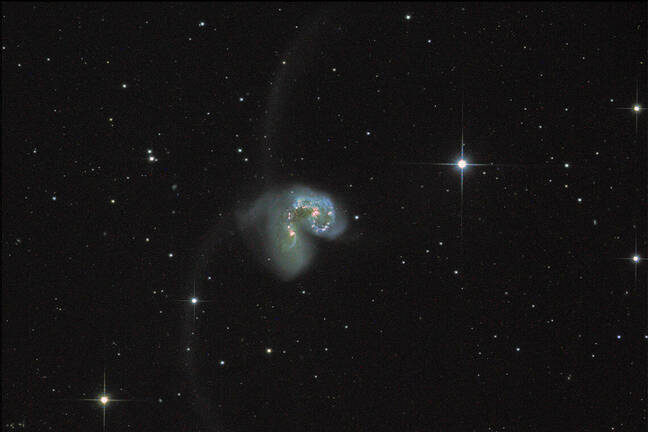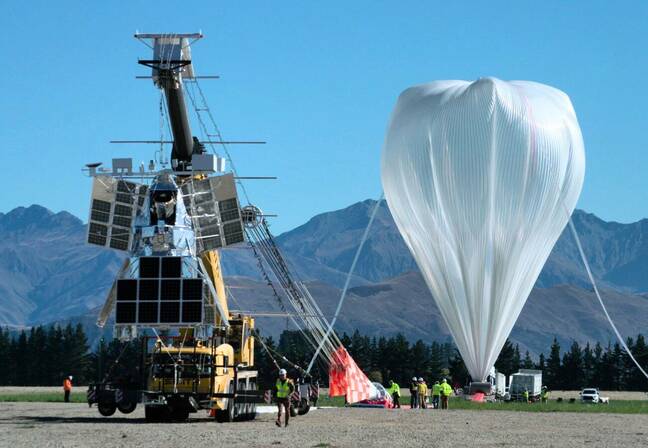Balloon-borne telescope returns first photos in search for dark matter
Helium is way cheaper than rocket fuel, and the pictures are just as good if you get high enough
The world's first wide-field, balloon-borne telescope has begun returning images to Earth, with scientists keen to begin months of imagery to help investigate the existence of dark matter.
The Super Pressure Balloon-Borne Imaging Telescope, or SuperBIT, has returned two publicly-shared images so far: The one of the Tarantula Nebula in the header of this article, and a second of a pair of colliding galaxies known as "the Antennae."
SuperBIT's main scientific objective is to measure the properties of dark matter, a term given to the invisible-yet-mathematically-required quarter of the matter in the universe that we're unable to see or detect in any way other than its interactions with gravity.
The telescope, a collaboration between the University of Toronto, Princeton University, Durham University and NASA, lifted off from New Zealand on April 16, and was carried to an altitude of 33.5 kilometers (20.8 miles) by one of NASA's stadium-sized super pressure balloons. At that altitude, SuperBIT is floating above all but the last half-percent of the Earth's atmosphere, giving it a level of visibility that ground-based telescopes can't match.
Because it sits outside of most of the atmosphere, SuperBIT isn't limited by anything but the laws of optics, and is able to take images with resolutions as high as the Hubble Space Telescope. It's also the first balloon-borne telescope to be able to capture wide-field images.
"SuperBIT will test whether dark-matter particles can bounce off each other, by mapping the dark matter around clusters of galaxies that are colliding with neighbouring galaxy clusters," said the University of Toronto.
SuperBIT is taking images via practice known as gravitational lensing, which takes advantage of how areas of dense gravity, like a pair of colliding galaxies or a massive stellar nursery, bend rays of light. Various theories suggest dark matter may slow down, spread or be chipped apart during a galactic collision, making the Antennae a particularly good observation point, according to the University of Toronto.
Balloons'll break, but not the budget
While it's in the air, SuperBIT will circumnavigate the southern hemisphere, taking images at night and using its array of solar panels to gather energy during the day. University of Toronto wasn't specific about the duration of the mission.
- Chinese scientists calculate the Milky Way's mass as 805 billion times that of our Sun
- Launching soon: ESA's Juice to probe Jupiter's moons for signs of possible life
- Astronomers clock runaway black hole leaving trail of fresh stars
- Research raises questions: Are instruments taken to Mars sensitive enough to find life?
The University of Toronto adds that the telescope would be "carried by seasonally stable winds for about three months," which may point to its mission duration corresponding to how well its giant balloon keeps the 3,500 lb (1,587 kg) gondola in the air.
So, why put a 0.5m telescope with optical sensitivity from the near-infrared to the near-ultraviolet that's able to stabilize itself with sub-arcsecond precision on a balloon? That's SuperBIT's other scientific objective.
"One of SuperBIT's overarching science and technology development goals is to make rapidly-developed yet highly capable sub-orbital astronomical platforms more accessible to the astronomical community at a fraction of the cost of an equivalent space- or satellite-based system of equivalent capability," University of Toronto said.
One of the graduate students at UofT working on the project told The Reg: "The planned duration of the flight is 100 days. It is not a hard deadline, and if the balloon is healthy then we could even go longer."
When we asked if there was a plan for recovery of the satellite, they told us: "This would depend on if we are able to land safely on land. There may be circumstances where we may have to bring the balloon down over water, in which case we may not be able to recover SuperBIT. But in case we're able to have it land on land, then there is high chance we can have it recovered and that is something NASA has plans on how to accomplish."
They added: "Reusability and time to relaunch depends on how the landing and recovery went. The 2019 flight's landing was a bit rough since it landed amongst trees and a lot of electronics did get stripped so they had to be remade (especially those on the outside of the telescope), as well as our mirrors that had to be rebuilt to ensure we can get quality science images.
"However there was still a lot that could be reused (and was) as well, such as inner electronics and the structural frame of the gondola, and more. A lot of testing is done to ensure anything that has been flown before is capable of being flown again. Sometimes this can also be to our advantage since certain models of electronics can be tested in test flights to verify if they will work in subsequent flights or not as well."
SuperBIT only cost around $5 million, significantly less than the cost of an equivalent satellite, the university said. That includes the costs to get it into the air - just the price of helium instead of rocket fuel and associated ground equipment, man hours and launch fees.
That, and SuperBIT is able to be returned to Earth safely on a parachute when its mission ends so it can be upgraded and relaunched. One upgrade is already planned once the telescope returns in a few months: It's getting a replacement that'll upgrade its aperture from 0.5m to 1.6m.
Funding for the upgrade has already been secured, meaning for its next mission SuperBIT will have ten times the ability to collect light and help scientists learn just what exactly dark matter gets up to out there in the depths of space. ®


